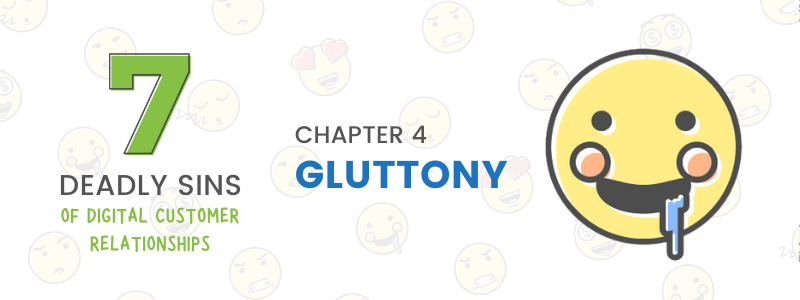The following was published as Chapter 4 of our series, The Seven Deadly Sins of Digital Customer Relationships. This chapter can be read by itself as a great introduction to the many benefits of digital verifiable credentials. However, if you’d like to start from the beginning, you can find the entire series here.

Application Programming Interfaces, or APIs, have had a profound impact across the digital economy. They have led to an always-on data stream that companies now feast on, shaping digital services from top to bottom: from bringing new consumer datasets together in new and interesting ways, to enabling new segmentation insights; from improving identity and verification processes to lower risk, to creating new personalized customer experiences and transforming how digital products work.
But executives are now asking how much data is being gathered and why. Is it all needed? Is it all valuable? Perhaps it’s time to ask if companies are over-eating on customer data, a sort of data gluttony. Apparently gluttony means “overconsumption to the point of waste.” Sadly that feels apt when it comes to customer data APIs.
Data data everywhere but not a drop to drink
It’s all happening because businesses treat customer data as an abundant resource. There’s so much of it, there’s enough to waste. They don’t need perfect data; just lots of it. Need more customer data? Just go and turn on the API tap.
It’s all happening because businesses treat customer data as an abundant resource.
To be clear, the API economy is a wonderful thing. But many businesses are now suffering to some extent from some unhealthy data habits, especially this over-eating.
So what can we do?
What if the customers themselves could help? To become active participants in the data sharing, rather than passive subjects in a hidden API? What if they could see – and perhaps even correct – the data about themselves?
Digital verifiable credentials are a technical and business breakthrough that will have a massive impact on business data diets. In simple terms, they are little data packages that have a digital watermark that gives them certain superpowers:
- They are easy to move around securely, privately, and at scale – and can be used anywhere by anyone, on any device;
- They are easy to accept and understand – businesses can use them in any context they want, and even use different technologies to handle them (there’s no tech vendor lock in as they are based on open standards);
- When implemented safely, the issuer of a credential can’t find out where or when a credential has been presented (…much like the government can’t know every time you share your driver’s license);
- They are hard to fake, and can be shared at a distance – with the same levels of assurance as if they had been presented face-to-face; and
- Unlike paper, they can be easily backed up under the control of the user.
Verifiable credentials have the potential to slow down – and potentially even reverse – the damaging effects of today’s data gluttony.
But back to gluttony and digital relationships. Verifiable credentials are based on freedom. To move. To prove. To combine. To flow. Verifiable credentials have the potential to slow down – and potentially even reverse – the damaging effects of today’s data gluttony. To wean companies off today’s data bad habits, especially where third parties are involved in so many customer data flows.
But it’s the economic and business arguments that make using verifiable credentials so attractive:
1. Businesses can significantly reduce external data checks
When a company can check the authenticity of customer data instantly – and with very high levels of assurance about who issued it and if it’s trustworthy – without having to contact the issuer directly, it changes the very economics of the data value chain.
No more relying on third-party data sources, brokers, or agents. No more APIs all over the place to secure, maintain, and update data at great expense. Leaner operations with higher margins. It’s simply better business.
2. Businesses can ask for less data
Rather than collect all the information on a bank statement, a business could only request proof of income. Rather than ask for the full university degree, they can just ask for the graduation date. Organizations today are collecting way too much information – at great expense – and verifiable credentials present a way to gather less data, and at a much higher quality.
3. Businesses can collect better, smarter, faster data
Consider the customer experience transformation that becomes possible when individuals can share a wide range of verifiable credentials from their own digital wallet – with just one tap. ‘Register, check-out, and pay’ in one click. Long forms can be completed using verifiable data in seconds – or possibly removed from the registration process completely.
All with highly secure, private and verifiable credential data, straight from the individual sharing it – rather than from a myriad of third-party sources and brokers.
Getting on the right data diet
Here’s the point: verifiable credentials give today’s businesses the opportunity to get ‘data fit’: to cut back on all these fatty data sources, these saturated APIs. It’s time to help businesses start on a healthier customer data diet. It should be a no-brainer, really: collect less data, and spend less money and time doing so. Build trusted customer relationships based on high quality, smarter data.
Businesses will be able to watch the pounds fall off as they get smarter about customers, get more nimble and healthier, and make better customer decisions with real, trusted customer data.
It’s time for companies to stop the data overeating, the data gluttony. Time to get in shape and wake up to a renewed, refreshed, and healthier customer relationship.


